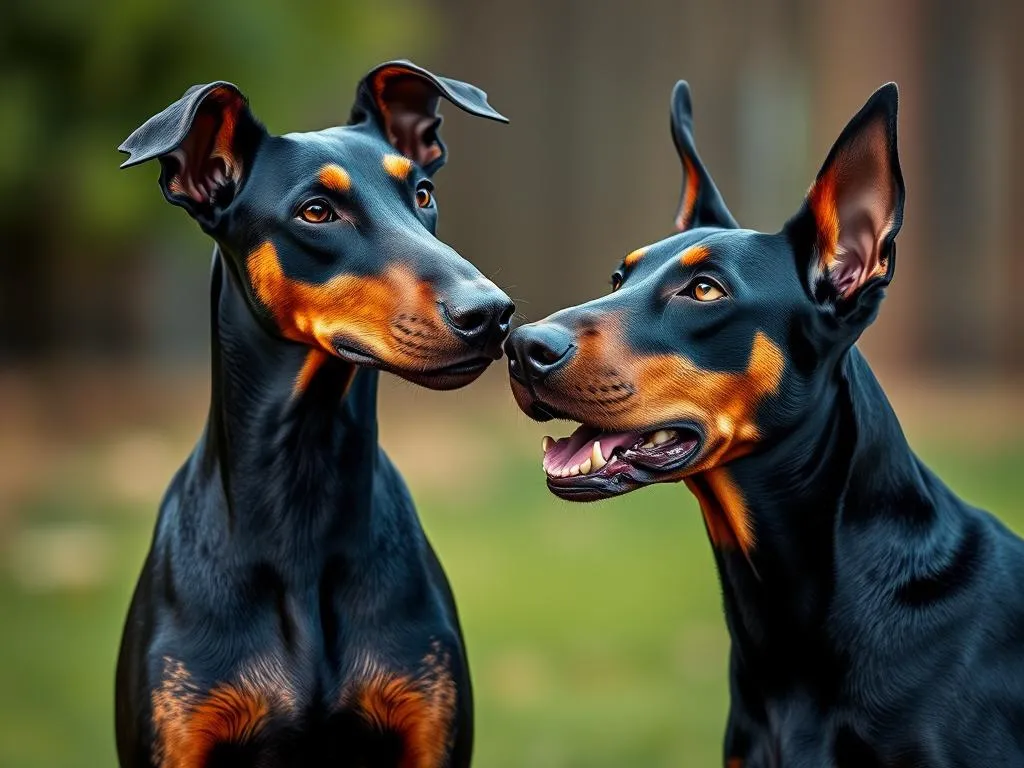
Understanding different dog breeds is crucial for prospective dog owners, as each breed comes with its own set of characteristics, needs, and suitability for various lifestyles. This article focuses on a detailed comparison of Manchester Terriers and Dobermans, two breeds that are often discussed for their distinct traits and temperaments. By examining the similarities and differences between these breeds, dog lovers can make informed decisions based on their personal preferences and living situations.
Breed Overview
Manchester Terrier
Origin and History
The Manchester Terrier is a small but mighty breed that originated in England during the 19th century. Initially bred for ratting and hunting small vermin, their agility and keen senses made them exceptional at these tasks. They were developed from the Black and Tan Terrier, and their popularity grew as a companion breed, known for their loyalty and spirited nature.
Physical Characteristics
Manchester Terriers are small dogs, typically weighing between 12 to 22 pounds and standing about 15 to 16 inches tall at the shoulder. They have a sleek, short coat, primarily black with tan markings, which gives them an elegant appearance. Their notable features include a long, narrow head, large, expressive eyes, and a wiry body that matches their energetic personality.
Temperament
Manchester Terriers are known for their lively and intelligent temperament. They are affectionate with their families but can be reserved around strangers. Their high energy levels require regular exercise, and they thrive in environments where they can play and explore. These dogs are alert and make excellent watchdogs due to their keen instincts.
Doberman Pinscher
Origin and History
The Doberman Pinscher was developed in Germany in the late 19th century by a tax collector named Karl Friedrich Louis Dobermann. He wanted a loyal and protective companion to accompany him on his rounds. The breed quickly gained popularity for its intelligence, strength, and versatility, often being used in police and military roles.
Physical Characteristics
Dobermans are medium to large-sized dogs, typically weighing between 60 to 100 pounds and standing 24 to 28 inches tall. They have a short, smooth coat that comes in several color variations, including black, red, blue, and fawn, often with rust-colored markings. Their athletic build, strong jaws, and prominent features give them an imposing presence.
Temperament
Known for their loyalty and protective instincts, Doberman Pinschers are intelligent, confident, and highly trainable. They are often affectionate with their families and can be reserved with strangers, making them excellent guard dogs. Their energy levels are also high, requiring regular exercise to keep them balanced and happy.
Comparison of Traits
Size and Appearance
Weight and Height
When comparing the sizes of the Manchester Terrier and the Doberman, it’s evident that the Doberman is significantly larger. While Manchester Terriers typically weigh between 12 to 22 pounds, Dobermans can weigh anywhere from 60 to 100 pounds. This difference in size can affect the dynamics of play, exercise, and even living arrangements.
Coat and Grooming Needs
Both breeds have short coats that require minimal grooming, making them relatively low-maintenance in this aspect. However, the Manchester Terrier may need more frequent baths due to their active nature, as they can get dirty from outdoor play. On the other hand, Dobermans do shed more, so regular brushing can help manage loose hair.
Temperament and Behavior
Socialization Needs
Socialization is crucial for both breeds. Manchester Terriers are generally friendly but can be wary of strangers if not properly socialized. They enjoy interacting with humans and other animals, especially if introduced at a young age. Dobermans, while also sociable, may take a more protective stance towards their families. Early socialization is essential to help them distinguish between a genuine threat and a friendly visitor.
Trainability
When it comes to trainability, Dobermans are often regarded as one of the most intelligent dog breeds, making them relatively easy to train. Their eagerness to please and quick learning ability can be advantageous for first-time dog owners. Manchester Terriers, while intelligent, may exhibit a stubborn streak, requiring patience and consistency in training. Both breeds benefit from positive reinforcement methods.
Exercise Requirements
Both breeds require regular exercise, but the intensity and duration may differ. Manchester Terriers thrive on daily walks and playtime, needing about 30 to 60 minutes of exercise. In contrast, Dobermans need more vigorous activity, typically requiring at least an hour of exercise daily, along with mental stimulation like obedience training or agility exercises.
Health Considerations
Common Health Issues
Both breeds have specific health considerations. Manchester Terriers are prone to certain genetic conditions, such as patellar luxation and certain eye disorders. Doberman Pinschers may face more serious health issues, including dilated cardiomyopathy (a heart condition), hip dysplasia, and von Willebrand’s disease (a bleeding disorder). Regular veterinary check-ups are crucial for both breeds to catch any potential health issues early.
Lifespan
The average lifespan of a Manchester Terrier is around 14 to 16 years, while Dobermans typically live between 10 to 13 years. Factors that affect their longevity include genetics, diet, exercise, and overall healthcare.
Suitability for Different Owners
Family Environment
Compatibility with Children
Both breeds can be great companions for families, but their compatibility with children may vary. Manchester Terriers are playful and generally good with kids, making them suitable for active families. However, supervision is essential because of their small size. Dobermans, being larger and more protective, can also be wonderful family pets but should be socialized well with children to ensure gentle interactions.
Living Conditions
In terms of living conditions, both breeds can adapt to apartment living, but they thrive in homes with ample space to roam and play. A yard is beneficial for both breeds, especially for Dobermans, who require more room for exercise. Owners should ensure that their living environment meets the exercise needs of their chosen breed.
First-Time vs. Experienced Owners
Best Fit for Different Owner Types
Manchester Terriers can be a suitable choice for first-time dog owners who are willing to invest time in training and socialization. Their smaller size and manageable exercise needs make them a good fit for various lifestyles. On the other hand, Dobermans are best suited for experienced dog owners who understand their training and socialization requirements. Their protective nature and high energy levels may be overwhelming for novice owners.
Training and Socialization
Training Techniques
Effective Methods for Each Breed
Training techniques for both breeds should include positive reinforcement, consistency, and patience. For Manchester Terriers, clicker training can be effective, as they respond well to rewards. For Dobermans, obedience training is crucial, and they often excel in more advanced training exercises due to their intelligence and eagerness to learn. Engaging both breeds in activities like obedience classes or agility training can enhance their skills and strengthen their bond with their owners.
Importance of Socialization
Socialization Needs
Early socialization is vital for both breeds to develop into well-rounded adult dogs. Manchester Terriers should be exposed to various people, animals, and environments to prevent shyness or aggression. Similarly, Dobermans need socialization to help them differentiate between friendly interactions and threats. Regular outings, puppy classes, and playdates can facilitate this process for both breeds.
Cost of Ownership
Initial Cost
Purchase Price
When considering the financial aspect of dog ownership, the initial purchase price of a Manchester Terrier typically ranges from $800 to $1,500, depending on the breeder and lineage. In contrast, Doberman Pinschers can cost anywhere from $1,500 to $3,000, reflecting their popularity and demand. Prospective owners should also consider adopting from shelters or breed-specific rescues as a cost-effective and compassionate option.
Ongoing Expenses
Food, Grooming, and Veterinary Care
Ongoing expenses for both breeds can vary. Manchester Terriers may incur lower food costs due to their smaller size, while Dobermans will require a higher quantity of quality dog food. Grooming costs for both breeds are relatively low, but Dobermans may need more frequent brushing due to shedding. Regular veterinary care, which includes vaccinations, preventive medications, and health screenings, is essential for both breeds and should be factored into the overall cost of ownership.
Conclusion
In summary, the comparison of Manchester Terriers vs. Dobermans reveals two distinct dog breeds with unique traits and characteristics. Manchester Terriers are small, energetic, and affectionate, making them great companions for active families and first-time owners. On the other hand, Dobermans are larger, protective, and incredibly trainable, suited for experienced owners who appreciate their loyalty and intelligence.
When choosing between these two remarkable breeds, consider your lifestyle, living conditions, and experience level as a dog owner. Each breed has its own set of rewards and challenges, and understanding these will help you make the best decision for your future furry friend.









